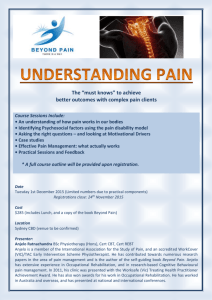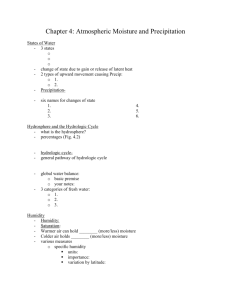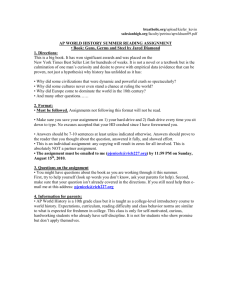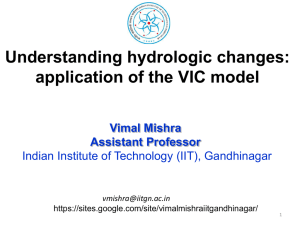Between-dataset difference in climate variables
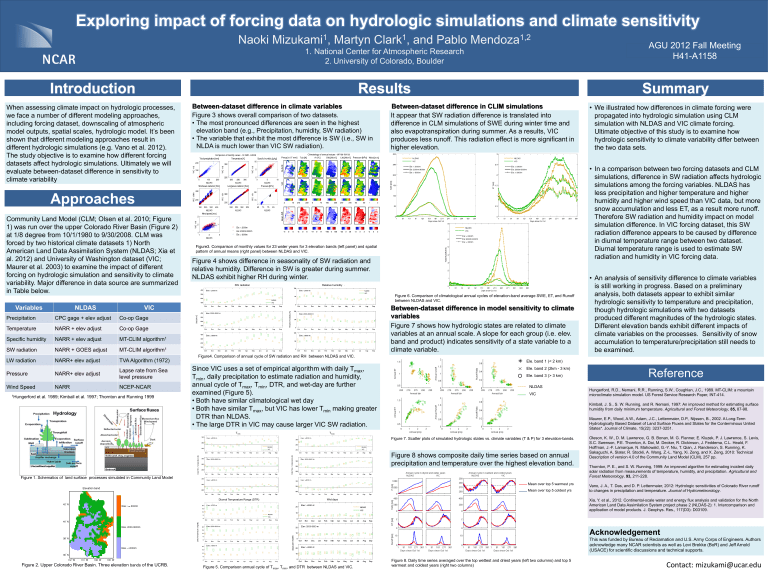
Exploring impact of forcing data on hydrologic simulations and climate sensitivity
Naoki Mizukami 1 , Martyn Clark 1 , and Pablo Mendoza 1,2
1. National Center for Atmospheric Research
2. University of Colorado, Boulder
AGU 2012 Fall Meeting
H41-A1158
Introduction
When assessing climate impact on hydrologic processes, we face a number of different modeling approaches, including forcing dataset, downscaling of atmospheric model outputs, s patial scales, hydrologic model. It’s been shown that different modeling approaches result in different hydrologic simulations (e.g. Vano et al. 2012).
The study objective is to examine how different forcing datasets affect hydrologic simulations. Ultimately we will evaluate between-dataset difference in sensitivity to climate variability
Approaches
Community Land Model (CLM; Olsen et al. 2010; Figure
1) was run over the upper Colorado River Basin (Figure 2) at 1/8 degree from 10/1/1980 to 9/30/2008. CLM was forced by two historical climate datasets 1) North
American Land Data Assimilation System (NLDAS; Xia et al. 2012) and University of Washington dataset (VIC;
Maurer et al. 2003) to examine the impact of different forcing on hydrologic simulation and sensitivity to climate variability. Major difference in data source are summarized in Table below.
Variables
Precipitation
NLDAS VIC
CPC gage + elev adjust Co-op Gage
Temperature
Specific humidity
NARR + elev adjust
NARR + elev adjust
Co-op Gage
MT-CLIM algorithm
1
MT-CLIM algorithm
1
SW radiation NARR + GOES adjust
LW radiation
Pressure
NARR+ elev adjust
NARR+ elev adjust
TVA Algorithm (1972)
Lapse rate from Sea level pressure
Wind Speed NARR NCEP-NCAR
1 Hungerford et al. 1989; Kimball et al. 1997; Thornton and Running 1999
Results
Between-dataset difference in climate variables
Figure 3 shows overall comparison of two datasets.
• The most pronounced differences are seen in the highest elevation band (e.g., Precipitation, humidity, SW radiation)
• The variable that exhibit the most difference is SW (i.e., SW in
NLDA is much lower than VIC SW radiation).
Between-dataset difference in CLIM simulations
It appear that SW radiation difference is translated into difference in CLM simulations of SWE during winter time and also evapotranspiration during summer. As a results, VIC produces less runoff. This radiation effect is more significant in higher elevation.
Figure3. Comparison of monthly values for 23 water years for 3 elevation bands (left panel) and spatial pattern of annual means (right panel) between NLDAS and VIC.
Figure 4 shows difference in seasonality of SW radiation and relative humidity. Difference in SW is greater during summer.
NLDAS exhibit higher RH during winter.
SW radiation Relative humidity
Figure4. Comparison of annual cycle of SW radiation and RH between NLDAS and VIC.
Since VIC uses a set of empirical algorithm with daily T max
,
T min
, daily precipitation to estimate radiation and humidity, annual cycle of T max
, T min
, DTR, and wet-day are further examined (Figure 5).
• Both have similar climatological wet day
• Both have similar T max
, but VIC has lower T min making greater
DTR than NLDAS.
• The large DTR in VIC may cause larger VIC SW radiation.
T min
T max
Figure 6. Comparison of climatological annual cycles of elevation-band average SWE, ET, and Runoff between NLDAS and VIC.
Between-dataset difference in model sensitivity to climate variables
Figure 7 shows how hydrologic states are related to climate variables at an annual scale. A slope for each group (i.e. elev. band and product) indicates sensitivity of a state variable to a climate variable.
Ele. band 1 (< 2 km)
Ele. band 2 (2km - 3 km)
Ele. band 3 (> 3 km)
NLDAS
VIC
Figure 7. Scatter plots of simulated hydrologic states vs. climate variables (T & P) for 3 elevation-bands.
Figure 8 shows composite daily time series based on annual precipitation and temperature over the highest elevation band.
Figure 1. Schematics of land surface processes simulated in Community Land Model
Mean over top 5 warmest yrs
Mean over top 5 coldest yrs
Wet days Diurnal Temperature Range (DTR)
Summary
• We illustrated how differences in climate forcing were propagated into hydrologic simulation using CLM simulation with NLDAS and VIC climate forcing.
Ultimate objective of this study is to examine how hydrologic sensitivity to climate variability differ between the two data sets.
• In a comparison between two forcing datasets and CLM simulations, difference in SW radiation affects hydrologic simulations among the forcing variables. NLDAS has less precipitation and higher temperature and higher humidity and higher wind speed than VIC data, but more snow accumulation and less ET, as a result more runoff.
Therefore SW radiation and humidity impact on model simulation difference. In VIC forcing dataset, this SW radiation difference appears to be caused by difference in diurnal temperature range between two dataset.
Diurnal temperature range is used to estimate SW radiation and humidity in VIC forcing data.
• An analysis of sensitivity difference to climate variables is still working in progress. Based on a preliminary analysis, both datasets appear to exhibit similar hydrologic sensitivity to temperature and precipitation, though hydrologic simulations with two datasets produced different magnitudes of the hydrologic states.
Different elevation bands exhibit different impacts of climate variables on the processes. Sensitivity of snow accumulation to temperature/precipitation still needs to be examined.
Reference
Hungerford, R.D., Nemani, R.R., Running, S.W., Coughlan, J.C., 1989. MT-CLIM: a mountain microclimate simulation model. US Forest Service Research Paper, INT-414.
Kimball, J. S., S. W. Running, and R. Nemani, 1997: An improved method for estimating surface humidity from daily minimum temperature. Agricultural and Forest Meteorology , 85, 87-98.
Maurer, E.P., Wood, A.W., Adam, J.C., Lettenmaier, D.P., Nijssen, B., 2002. A Long-Term
Hydrologically Based Dataset of Land Surface Fluxes and States for the Conterminous United
States*. Journal of Climate, 15(22): 3237-3251.
Oleson, K. W., D. M. Lawrence, G. B. Bonan, M. G. Flanner, E. Kluzek, P. J. Lawrence, S. Levis,
S.C. Swenson, P.E. Thornton, A. Dai, M. Decker, R. Dickinson, J. Feddema, C.L. Heald, F.
Hoffman, J.-F. Lamarque, N. Mahowald, G.-Y. Niu, T. Qian, J. Randerson, S. Running, K.
Sakaguchi, A. Slater, R. Stockli, A. Wang, Z.-L. Yang, Xi. Zeng, and X. Zeng, 2010: Technical
Description of version 4.0 of the Community Land Model (CLM), 257 pp.
Thornton, P. E., and S. W. Running, 1999: An improved algorithm for estimating incident daily solar radiation from measurements of temperature, humidity, and precipitation. Agricultural and
Forest Meteorology , 93, 211-228.
Vano, J. A., T. Das, and D. P. Lettenmaier, 2012: Hydrologic sensitivities of Colorado River runoff to changes in precipitation and temperature. Journal of Hydrometeorology .
Xia, Y. et al., 2012. Continental-scale water and energy flux analysis and validation for the North
American Land Data Assimilation System project phase 2 (NLDAS-2): 1. Intercomparison and application of model products. J. Geophys. Res., 117(D3): D03109.
Figure 2. Upper Colorado River Basin. Three elevation bands of the UCRB.
Figure 8. Daily time series averaged over the top wettest and driest years (left two columns) and top 5 warmest and coldest years (right two columns)
Acknowledgement
This was funded by Bureau of Reclamation and U.S. Army Corps of Engineers. Authors acknowledge many NCAR scientists as well as Levi Brekke (BoR) and Jeff Arnold
(USACE) for scientific discussions and technical supports.
Contact: mizukami@ucar.edu
Figure 5. Comparison annual cycle of T max
, T min
, and DTR between NLDAS and VIC.


